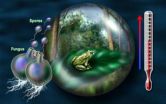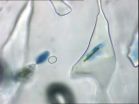(Press-News.org) With the steep decline in populations of many animal species, scientists have warned that Earth is on the brink of a mass extinction like those that have occurred just five times during the past 540 million years.
Each of these "Big Five" saw three-quarters or more of all animal species go extinct.
In results of a study published in this week's issue of journal Nature, researchers report on an assessment of where mammals and other species stand today in terms of possible extinction compared with the past 540 million years.
They find cause for hope--and alarm.
"If you look only at the critically endangered mammals--those where the risk of extinction is at least 50 percent within three of their generations--and assume that their time will run out and they will be extinct in 1,000 years, that puts us clearly outside any range of normal and tells us that we are moving into the mass extinction realm," said Anthony Barnosky, an integrative biologist at the University of California at Berkeley, and first author of the paper.
Barnosky is also a curator in the university's Museum of Paleontology and a research paleontologist in its Museum of Vertebrate Zoology.
"A modern global mass extinction is a largely unaddressed hazard of climate change and human activities," said H. Richard Lane, program director in the National Science Foundation's (NSF) Division of Earth Sciences, which funded the research.
"Its continued progression, as this paper shows, could result in unforeseen--and irreversible--consequences to the environment and to humanity," said Lane.
If currently threatened species--those officially classed as critically endangered, endangered, and vulnerable--actually went extinct, and that rate of extinction continued, the sixth mass extinction could arrive in as little as 3 to 22 centuries, according to Barnosky.
It's not too late, he and colleagues believe, to save endangered mammals and other such species--and stop short of the tipping point.
That would require dealing with a perfect storm of threats, including habitat fragmentation, invasive species, disease and global warming.
"So far, only 1 to 2 percent of all species have gone extinct in the groups we can look at clearly, so by those numbers it looks like we are not far down the road to extinction," said Barnosky.
"We still have a lot of Earth's biota to save."
Co-author Charles Marshall, also an integrative biologist at UC-Berkeley and director of the university's Museum of Paleontology, emphasized that the small number of recorded extinctions to date does not mean we are not in a crisis.
"Just because the magnitude is low compared to the biggest mass extinctions we've seen in half a billion years doesn't mean they aren't significant," he said.
"Present rates are higher than during most past mass extinctions."
The study originated in a seminar Barnosky organized to bring biologists and paleontologists together in an attempt to compare the extinction rate seen in the fossil record with today's extinction record.
They're like comparing apples and oranges, Barnosky said. The fossil record goes back 3.5 billion years, while the historical record goes back only a few thousand years.
In addition, the fossil record has many holes, making it impossible to count every species that evolved and subsequently disappeared, perhaps, scientists believe, some 99 percent of all species that have ever existed.
Likewise, a different set of data problems complicates counting modern extinctions.
Dating of the fossil record also is not very precise, Marshall said.
"If we find a mass extinction, we have great difficulty determining whether it was a 'bad weekend' or it occurred over a decade or 10,000 years," he said.
"But without the fossil record, we have no scale to measure the significance of the impact we're having."
"Instead of calculating a single death rate, we estimated the range of plausible rates for mass extinctions from the fossil record, and compared it to where we are now," Marshall said, explaining how researchers got around this limitation.
Barnosky's team chose mammals as a starting point because they are well-studied today and are well-represented in the fossil record going back some 65 million years.
Biologists estimate that within the past 500 years, at least 80 mammal species have gone extinct--from a starting total of 5,570 species.
The team's estimate for the average extinction rate for mammals is less than two extinctions every million years, far lower than the current extinction rate for mammals.
"It looks like modern extinction rates resemble mass extinction rates, even after setting a high bar for defining 'mass extinction,'" Barnosky said.
After studying the list of threatened species maintained by the International Union for Conservation of Nature (IUCN), the team concluded that if all mammals now listed as critically endangered, endangered and threatened go extinct--and whether that takes several hundred years or a thousand years--the Earth will be in a true mass extinction.
"Obviously there are caveats," Barnosky said.
"What we know is based on observations from just a very few twigs plucked from an enormous number of branches that make up the tree of life."
He urges similar studies of groups other than mammals to confirm the findings, as well as action to combat the loss of animal and plant species.
"Our findings highlight how essential it is to save critically endangered, endangered and vulnerable species," Barnosky said.
"With them, Earth's biodiversity remains in pretty good shape compared to the long-term biodiversity baseline.
"If most of them die, even if their disappearance is stretched out over the next 1,000 years, the sixth mass extinction will have arrived."
INFORMATION:
Co-authors of the paper are: UC-Berkeley integrative biology graduate students Nicholas Matzke, Susumu Tomiya, Guinevere Wogan, Brian Swartz, Emily Lindsey, Kaitlin Maguire, Ben Mersey and Elizabeth Ferrer; Tiago Quental, a post-doctoral fellow at the University of Sao Paulo, Brazil; and Jenny McGuire, post-doctoral fellow at the National Evolutionary Synthesis Center at Duke University in Durham, North Carolina.
Earth's sixth mass extinction: Is it almost here?
Steep decline of many animal species warns that Earth is on the brink
2011-03-04
ELSE PRESS RELEASES FROM THIS DATE:
Jekyll and Hyde: Cells' executioner can also stave off death
2011-03-04
ATLANTA -- An enzyme viewed as an executioner, because it can push cells to commit suicide, may actually short circuit a second form of cell death, researchers at Emory University School of Medicine have discovered.
The finding could shift drug discovery efforts, by leading scientists to rethink how proposed anti-cancer and anti-inflammatory drugs that target the enzyme, called caspase 8, are supposed to work. The results are described in this week's Nature.
Caspase 8 has been described as "the killer you can't live without." This enzyme plays a key role in apoptosis, ...
Algal antifreeze makes inroads into ice
2011-03-04
Sea-ice algae – the important first rung of the food web each spring in places like the Arctic Ocean – can engineer ice to its advantage, according to the first published findings about this ability.
The same gel-like mucus secreted by sea-ice algae as a kind of antifreeze against temperatures well below minus 10 C is also allowing algae to sculpt microscopic channels and pores in ice that are hospitable to itself and other microorganisms.
Altering ice to their benefit should help sea-ice algae adapt to a warming world, which is good news for hungry fish and shellfish ...
Fraser Yachts Announce New Yacht Listings for Charter
2011-03-04
Fraser Yachts is pleased to announce the following charters available for Mediterranean yacht charter and Caribbean yacht charter for 2011/12. M/Y Pamela V yacht is a luxurious 45.9m Hakvoort built yacht, available for yacht charter in the Bahamas and the British Virgin Islands. During the high season, it will be available for $235,000 per week and in the low season will go down to $220,000. Currently located in the Caribbean, this luxury yacht is due to be completed later this year. With the ability to sleep 8 guests in 4 staterooms, and 10 crew members, you can expect ...
In search of cancer's common ground: A next-generation view
2011-03-04
Researchers have synthesized the vast literature on cancer to produce a next-generation view of the features that are shared amongst all cancer cells. These hallmarks of the disease provide a comprehensive and cohesive foundation for the field that will influence biomedical researchers in their quest for new cancer treatments.
The review article by Douglas Hanahan of École Polytechnique Fédérale in Switzerland and Robert Weinberg of the Whitehead Institute for Biomedical Research appears in the March 4th issue of Cell, a Cell Press publication. The new article updates ...
Kidney transplant recipients: Get moving to save your life
2011-03-04
Low physical activity increases kidney transplant patients' likelihood of dying early, according to a study appearing in an upcoming issue of the Clinical Journal of the American Society Nephrology (CJASN). The results suggest that patients need to exercise to fend off an early death.
Inactive people in general face increased risks of developing cardiovascular disease and of dying prematurely. Individuals with chronic kidney disease—particularly those on dialysis—tend to get little exercise, but most increase their activity levels modestly after receiving a kidney transplant. ...
California islands give up evidence of early seafaring
2011-03-04
Evidence for a diversified sea-based economy among North American inhabitants dating from 12,200 to 11,400 years ago is emerging from three sites on California's Channel Islands.
Reporting in the March 4 issue of Science, a 15-member team led by University of Oregon and Smithsonian Institution scholars describes the discovery of scores of stemmed projectile points and crescents dating to that time period. The artifacts are associated with the remains of shellfish, seals, geese, cormorants and fish.
Funded primarily by grants from the National Science Foundation, the ...
Fossils of horse teeth indicate 'you are what you eat,' according to NYCOM researchers
2011-03-04
Old Westbury, New York (Mar. 3, 2011) – Fossil records verify a long-standing theory that horses evolved through natural selection, according to groundbreaking research by two anatomy professors at New York College of Osteopathic Medicine (NYCOM) of New York Institute of Technology.
Working with colleagues from Massachusetts and Spain, Matthew Mihlbachler, Ph.D., and Nikos Solounias, Ph.D. arrived at the conclusion after examining the teeth of 6,500 fossil horses representing 222 different populations of more than 70 extinct horse species. The records, spanning the past ...
Optical tweezers software now available for the iPad
2011-03-04
Optics researchers from the Universities of Glasgow and Bristol have developed an iPad application for accurate, easy and intuitive use of optical tweezers.
Optical tweezers, used to manipulate tiny particles through the use of highly focused laser beams, are the tool at the heart of much molecular biology – helping us to experiment with and better understand the microscopic processes of organisms.
Research published today, Friday 4 March 2011, in IOP Publishing's Journal of Optics, shows how a team of researchers has overcome the limitations of computer mouse and ...
Johns Hopkins team explores PARIS; finds a key to Parkinson's
2011-03-04
Johns Hopkins scientists have discovered that PARIS — the protein — facilitates the most common form of Parkinson's disease (PD), which affects about 1 million older Americans. The findings of their study, published March 4 in Cell, could lead to important new targets for treatment.
Previous research has shown that a protein dubbed parkin protects brain cells by "tagging" certain toxic elements for natural destruction. Mutations in the parkin gene cause rare forms of PD that run in families, but its role remained unclear in sporadic late-onset PD, the prevalence of which ...
Star-shaped brain cells feed long-term memory
2011-03-04
Star-shaped cells in our brains called astrocytes were once considered little more than structures to fill the gaps between all-important neurons. But more recent evidence has emerged to reveal that those astrocytes play more than a supporting role; they are involved in information processing and signal transmission and they help to regulate the shapes of our neurons and their connections to one another.
Now, researchers reporting in the March 4th Cell, a Cell Press publication, have found that astrocytes are also essential for making long-term memories. When they don't ...
LAST 30 PRESS RELEASES:
Making lighter work of calculating fluid and heat flow
Normalizing blood sugar can halve heart attack risk
Lowering blood sugar cuts heart attack risk in people with prediabetes
Study links genetic variants to risk of blinding eye disease in premature infants
Non-opioid ‘pain sponge’ therapy halts cartilage degeneration and relieves chronic pain
AI can pick up cultural values by mimicking how kids learn
China’s ecological redlines offer fast track to 30 x 30 global conservation goal
Invisible indoor threats: emerging household contaminants and their growing risks to human health
Adding antibody treatment to chemo boosts outcomes for children with rare cancer
Germline pathogenic variants among women without a history of breast cancer
Tanning beds triple melanoma risk, potentially causing broad DNA damage
Unique bond identified as key to viral infection speed
Indoor tanning makes youthful skin much older on a genetic level
Mouse model sheds new light on the causes and potential solutions to human GI problems linked to muscular dystrophy
The Journal of Nuclear Medicine ahead-of-print tip sheet: December 12, 2025
Smarter tools for peering into the microscopic world
Applications open for funding to conduct research in the Kinsey Institute archives
Global measure underestimates the severity of food insecurity
Child survivors of critical illness are missing out on timely follow up care
Risk-based vs annual breast cancer screening / the WISDOM randomized clinical trial
University of Toronto launches Electric Vehicle Innovation Ontario to accelerate advanced EV technologies and build Canada’s innovation advantage
Early relapse predicts poor outcomes in aggressive blood cancer
American College of Lifestyle Medicine applauds two CMS models aligned with lifestyle medicine practice and reimbursement
Clinical trial finds cannabis use not a barrier to quitting nicotine vaping
Supplemental nutrition assistance program policies and food insecurity
Switching immune cells to “night mode” could limit damage after a heart attack, study suggests
URI-based Global RIghts Project report spotlights continued troubling trends in worldwide inhumane treatment
Neutrophils are less aggressive at night, explaining why nighttime heart attacks cause less damage than daytime events
Menopausal hormone therapy may not pose breast cancer risk for women with BRCA mutations
Mobile health tool may improve quality of life for adolescent and young adult breast cancer survivors
[Press-News.org] Earth's sixth mass extinction: Is it almost here?Steep decline of many animal species warns that Earth is on the brink



